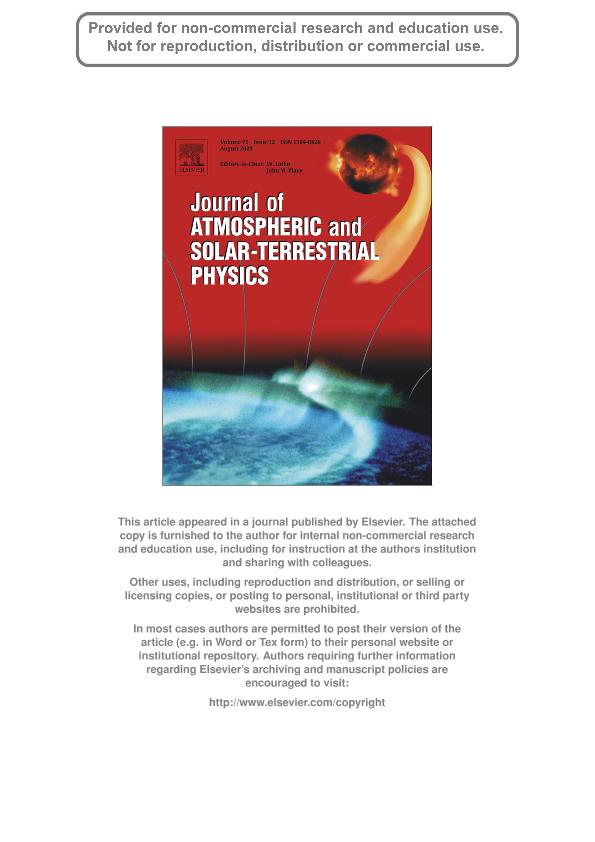Mostrar el registro sencillo del ítem
dc.contributor.author
Meza, Amalia Margarita

dc.contributor.author
Van Zele, Maria Andrea

dc.contributor.author
Rovira, Marta Graciela

dc.date.available
2017-07-28T19:57:46Z
dc.date.issued
2009-08
dc.identifier.citation
Meza, Amalia Margarita; Van Zele, Maria Andrea; Rovira, Marta Graciela; Solar flare effect on the geomagnetic field and ionosphere; Elsevier; Journal of Atmospheric and Solar-Terrestrial Physics; 71; 12; 8-2009; 1322-1332
dc.identifier.issn
1364-6826
dc.identifier.uri
http://hdl.handle.net/11336/21575
dc.description.abstract
This paper studies the ionospheric and geomagnetic response to an X6.2 solar flare recorded at 14:30 UT on December 13, 2001, in quiet geomagnetic conditions which allow the variations in the geomagnetic field and ionosphere measurements to be easily related to the solar flare radiation. By using measurements from the global positioning system (GPS) and geomagnetic observatories, the temporal evolution of ionospheric total electron content variation, vTECV, and geomagnetic field variations, [delta]B, as well as their rates of variation, were obtained around the subsolar point at different solar zenith angles. The enhancement of both parameters was recorded one to three minutes later than the Geostationary Operational Environmental Satellite (GOES) programme recording; such delay tends to depend on the latitude, longitude, and solar zenith angle of the observatory's observations. The vTECV is related to the local time and the [delta]B to the intensity and position of the ionospheric currents. The vTECV's maximum value is always recorded later than the maximum values reached by [delta]B and the X-ray intensity. The maximum [delta]B is larger in the local morning than in the afternoon. The rates of vTECV and [delta]B have two maximum values at the same time as the maximum values recorded by H[alpha] (for each ribbon). This work shows the quantitative and qualitative relations between a solar flare and the ionospheric and geomagnetic variations that it produces.
dc.format
application/pdf
dc.language.iso
eng
dc.publisher
Elsevier

dc.rights
info:eu-repo/semantics/openAccess
dc.rights.uri
https://creativecommons.org/licenses/by-nc-sa/2.5/ar/
dc.subject
Flare
dc.subject
Vtec
dc.subject
Geomagnetic Field
dc.subject.classification
Meteorología y Ciencias Atmosféricas

dc.subject.classification
Ciencias de la Tierra y relacionadas con el Medio Ambiente

dc.subject.classification
CIENCIAS NATURALES Y EXACTAS

dc.title
Solar flare effect on the geomagnetic field and ionosphere
dc.type
info:eu-repo/semantics/article
dc.type
info:ar-repo/semantics/artículo
dc.type
info:eu-repo/semantics/publishedVersion
dc.date.updated
2017-07-28T15:05:11Z
dc.journal.volume
71
dc.journal.number
12
dc.journal.pagination
1322-1332
dc.journal.pais
Países Bajos

dc.journal.ciudad
Amsterdam
dc.description.fil
Fil: Meza, Amalia Margarita. Universidad Nacional de la Plata. Facultad de Ciencias Astronómicas y Geofísicas; Argentina
dc.description.fil
Fil: Van Zele, Maria Andrea. Universidad de Buenos Aires. Facultad de Ciencias Exactas y Naturales; Argentina
dc.description.fil
Fil: Rovira, Marta Graciela. Consejo Nacional de Investigaciónes Científicas y Técnicas. Oficina de Coordinación Administrativa Ciudad Universitaria. Instituto de Astronomía y Física del Espacio. - Universidad de Buenos Aires. Facultad de Ciencias Exactas y Naturales. Instituto de Astronomía y Física del Espacio; Argentina
dc.journal.title
Journal of Atmospheric and Solar-Terrestrial Physics

dc.relation.alternativeid
info:eu-repo/semantics/altIdentifier/doi/http://dx.doi.org/10.1016/j.jastp.2009.05.015
dc.relation.alternativeid
info:eu-repo/semantics/altIdentifier/url/http://www.sciencedirect.com/science/article/pii/S1364682609001229
Archivos asociados
